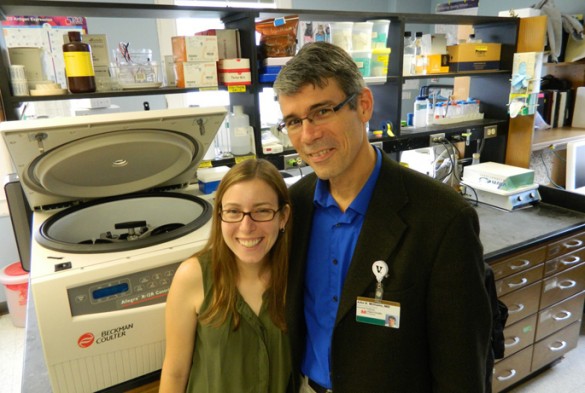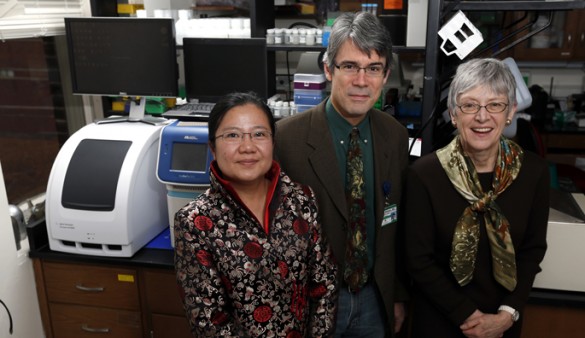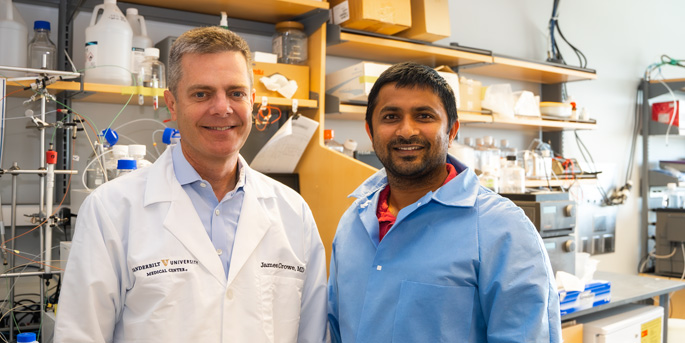New Vanderbilt-led research published in the Journal of Infectious Diseases has identified an antibody that shows promise in preventing and treating human metapneumovirus (MPV) and respiratory syncytial virus (RSV) — the two leading causes of respiratory infections in young children.

Lead author Jennifer Schuster, M.D., clinical fellow in Pediatric Infectious Diseases, said the identification of the human antibody, known as 54G10, has huge implications and could pave the way to identify one vaccine for both viruses. Antibodies are produced by the body’s immune system to fight off bacteria and viruses.
“I think it will change the way people think about vaccines. The dogma in the field has always been that antibodies to one virus don’t neutralize the other virus,” Schuster said. “Although MPV and RSV are related and cause identical clinical disease, they are different enough genetically that the immune system doesn’t react to both of them simultaneously. We discovered that they are similar enough that we can find one target to trick the immune system to react to both of them.”
RSV and MPV are No. 1 and No. 2, respectively, for causing lower respiratory infections in infants and children, with high morbidity and mortality in at-risk populations. Currently, no specific treatment or preventative exists for MPV. The medication Synagis can be given to at-risk infants for prevention of RSV, but is not effective as a treatment option.
“RSV is far and away the leading cause of respiratory tract infections in kids under age 5 and MPV is second,” Schuster said. “In adults over the age of 65, RSV and MPV are also leading causes of respiratory infections.
“We vaccinate against influenza, but other viruses also cause significant morbidity and mortality in neonates, elderly, cancer and HIV patients, adults with COPD (chronic obstructive pulmonary disease) and transplant patients.”
Both viral infections strike in late winter or spring, though MPV has a seasonal peak that lags behind the typical peak for RSV by about a month.
Schuster and co-authors carried out the research from July 2012 to January 2014, looking at the efficacy of the antibody 54G10, which was isolated by co-authors Anthony Williamson and Dennis Burton at The Scripps Research Institute.
The study first explored antibody 54G10’s effectiveness in neutralizing the four subgroups of MPV as passive immune prophylaxis and therapy. In the process, Schuster developed a new mouse model that could — for the first time — support infection by all four types of MPV. The 54G10 antibody targets the MPV fusion protein, a viral protein that participates in getting the virus inside cells, and successfully reduced virus and disease in all subgroups.
Further examination showed the antibody also worked to neutralize RSV because one region of the RSV fusion protein was similar to the region of the MPV fusion protein recognized by 54G10. Only one prior study in December 2013 by a group in Italy has identified another antibody that has activity against both MPV and RSV.
Senior author John Williams, M.D., associate professor of Pediatrics and of Pathology, Microbiology and Immunology, said that a shared protein region could be the key to unlocking a vaccine.
“So now we know this analogous part of the protein that the antibody binds to; could we use that piece of the protein as a vaccine to recreate this antibody in humans — one vaccine, two viruses?” Williams said. “Essentially, you’re creating the Achilles heel of the virus.”
Other authors on the study include: Reagan Cox and Andrew Hastings, Vanderbilt Department of Pathology, Microbiology and Immunology; Kelli Boyd, Ph.D., associate professor of Pathology, Microbiology and Immunology; Jay Wadia, of the Crucell Vaccine Institute; and Zhifeng Chen, at the Scripps Research Institute.
Funding for the study was provided by the National Institutes of Health (grant R01 AI085062 to J.V.W., grant R01AI072414 to D.R.B., and 5T32HD060554 to J.E.S) and a CTSA award (UL1TR0005445) from the National Center for Advancing Translational Sciences.















